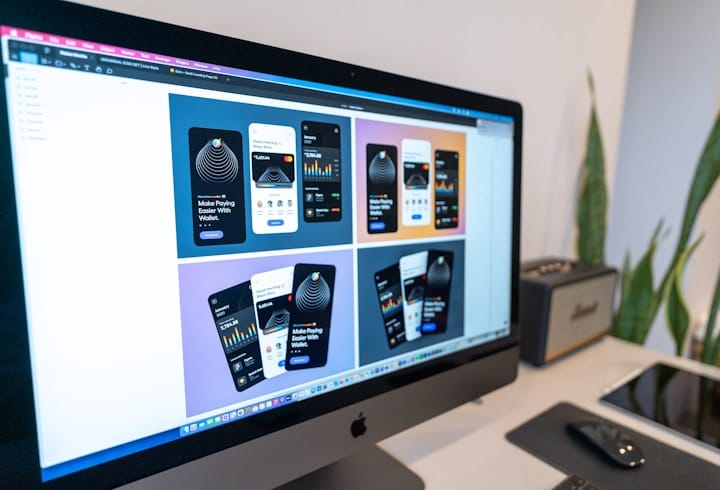Introduction
In the realm of User Experience (UX) design, every detail counts. While large-scale design choices such as layout, color schemes, and content are often the focal points, an often neglected yet equally influential element is micro-interactions. These subtle, effective elements can significantly enhance user satisfaction and engagement if utilized thoughtfully.
Micro-interactions refer to small, design elements that revolve around a single task—like a button animation, a progress indicator, or a notification alert—creating a more interactive and immersive user experience. As users engage with an application or website, these micro-interactions play a vital role in not only guiding them through processes but also in eliciting emotional responses that can significantly elevate the overall UX.
In this blog post, we will delve deep into the world of micro-interactions, exploring their importance, how they influence user engagement, and how to effectively incorporate them into UX design, ultimately leading to a seamless user experience.
Skip Ahead
- Understanding Micro-Interactions
- The Importance of Micro-Interactions in UX
- Types of Micro-Interactions
- Best Practices for Implementing Micro-Interactions
- Tools and Techniques for Designing Micro-Interactions
- Micro-Interactions and Mobile UX
- Case Studies: Successful Use of Micro-Interactions
- Measuring the Impact of Micro-Interactions
Understanding Micro-Interactions
Micro-interactions are the small, often unnoticed design elements that handle specific tasks within a product. These interactions aid in communication and usability, making the user's journey more intuitive and engaging. A micro-interaction typically consists of four major elements:
- Trigger: This starts the micro-interaction and can be device-based (like clicking a button) or user-initiated (swiping a screen).
- Rules: These define what happens when the interaction occurs. Rules dictate how the system will respond to the user's action, such as displaying a loading icon or changing button color.
- Feedback: This element answers the user's action, showing that their interaction has been recognized. Feedback can manifest as visual changes, animations, sounds, or haptic responses.
- Loop and Modes: This includes systems that allow repeated actions, where the outcome can change based on the user's interaction over time—like notifications or user points accumulation mechanics.
Micro-interactions, even though they are perceived as minor details, are crucial in communicating the product's state, enhancing usability, and creating an emotional bond between the user and the product.

The Importance of Micro-Interactions in UX
Micro-interactions play a critical role in shaping the overall user experience. Here are a few key reasons why they are essential:
1. Enhances Usability
Micro-interactions simplify user tasks, providing clear instructions without overwhelming them. For instance, animated buttons that indicate loading status can convey to the user that an action is in progress, anchoring their expectations.
2. Provides Feedback
Every action taken by the user deserves acknowledgment. Micro-interactions provide clear feedback—be it a vibration when a button is pressed or a visual cue when a form is submitted—helping to reinforce the user's action.
3. Increases Engagement
Subtle animations and interactions attract users’ attention. Consider a shopping app that features a delightful animation when an item is added to the cart; these little surprises can encourage further exploration and retention.
4. Establishes Trust
Micro-interactions can also establish user trust. For example, a password-validator that visually responds to user inputs can reassure users that they are meeting security standards, thus increasing trust in the application.
5. Humanizes Technology
Micro-interactions add character to a product. Thoughtful design touches such as hover effects or delightful animations elicit positive emotions and create a connection between the user and the interface, lending a human touch to technology.
By strategically implementing micro-interactions, designers can significantly improve user experience, leading to higher satisfaction and increased user loyalty.
Types of Micro-Interactions
Micro-interactions come in various forms and can be implemented at different stages of user engagement. Below are some common types:
1. Animation Effects
Animating elements can enhance a product’s dynamism, guiding the user’s attention effortlessly. Examples include button hover animations, loading indicators, and scrolling effects.
2. Notifications and Alerts
Notifications alert users to significant changes within the system, providing real-time feedback. This encompasses everything from new messages to reminders or alerts for status updates.
3. Onboarding Experiences
Micro-interactions can help introduce users to new features or empower them with personalized setups. Walkthroughs, highlighting elements, or indicating progress through stages add clarity to onboarding processes.
4. Input Validation
Real-time input validation is a prevalent micro-interaction, communicating errors or success while filling out forms. For instance, showing green checks next to correctly filled fields can lead to an enhanced user experience.
5. Status Updates
Users often want to know the status of their requests or activities. Micro-interactions like progress bars or completion animations aid in visualizing these updates, keeping users in the loop.
By incorporating these types of micro-interactions into your design, you can create a more engaging, user-friendly product that meets the expectations of modern consumers.
Interface Displaying Various Micro-Interactions
Best Practices for Implementing Micro-Interactions
To successfully integrate micro-interactions into your UX design, consider the following best practices:
1. Keep It Simple
While micro-interactions are intended to enhance the user experience, it's essential to ensure they remain simple and unobtrusive. A cluttered interface can overwhelm users, causing confusion and frustration.
2. Prioritize Feedback
Always prioritize user feedback in micro-interaction designs. Every user action should provoke an immediate and gentle response, reinforcing their interaction with the product.
3. Align with User Goals
Micro-interactions should serve a purpose that aligns with user goals. Consider what the user is trying to achieve and design interactions that facilitate their overall experience.
4. Test and Iterate
Micros-interactions may be subtle, but they can significantly impact UX. Conduct usability testing to gather user feedback and iterate based on findings. Testing helps to identify which interactions are effective and which require refinement.
5. Maintain Consistency
Consistency in micro-interactions fosters familiarity. Use similar feedback styles, animations, and transition effects across the product to maintain a cohesive experience.
By following these best practices for micro-interactions, designers can better connect with users, alleviate frustrations, and ultimately enhance usability and engagement throughout their applications.
Tools and Techniques for Designing Micro-Interactions
Leveraging the right tools is essential for crafting effective micro-interactions. Here are several notable tools and techniques designers can use:
1. Sketch
Sketch is a popular design tool that supports vector graphics, making it ideal for creating wireframes and prototypes while facilitating the design of micro-interactions.
2. Adobe XD
Adobe XD offers comprehensive features for designing interactive prototypes, allowing designers to easily animate micro-interactions and preview them in real time.
3. Principle
Principle is a prototyping tool that allows designers to create intricate motion and interactions, enabling detailed feedback on micro-interaction design ideas.
4. After Effects
Adobe After Effects can create stunning motion graphics and animations that can be exported for use in applications, enhancing the look and feel of micro-interactions.
5. Framer
Framer provides a robust platform for designing, prototyping, and collaborating on interactive designs, making it easier to incorporate micro-interactions seamlessly into UX projects.
These tools can facilitate and enhance the creation of effective micro-interactions, ultimately contributing to a better overall user experience.

Micro-Interactions and Mobile UX
In today's mobile-first landscape, micro-interactions are even more critical for enhancing user experiences on mobile devices. A seamless mobile UX can offer significant advantages in engaging users, especially due to limited screen real estate. Here’s how micro-interactions can affect mobile UX:
1. Guidance in Navigation
Mobile users often rely on visual cues to navigate through apps. Micro-interactions can elucidate navigation paths, such as animated buttons that change colors or positions when tapped.
2. Enhancing Touch Feedback
Touch-enabled devices require immediate feedback on user actions. Micro-interactions, such as tactile feedback, can reinforce the user's actions and improve responsiveness in mobile applications.
3. Optimizing Loading Times
Mobile apps need to manage bandwidth effectively, especially with variable connectivity. Micro-interactions can provide dynamic loading indicators or animations to keep users engaged while content loads.
4. Streamlining Onboarding
For successful app adoption, streamlined onboarding processes are vital. Micro-interactions can guide users through setup procedures using interactive visuals and progress indicators, reducing friction in the initial user journey.
Adapting micro-interactions for mobile experiences enhances usability, showcasing the importance of these elements in modern application design.
Case Studies: Successful Use of Micro-Interactions
Case studies serve as rich examples of how brands effectively leveraged micro-interactions to enhance UX. Here are two notable cases:
1. Facebook's "Like" Button
Facebook employed micro-interactions through its "Like" button, enhancing user engagement and feedback visibility. The button expands and animates upon clicking, giving real-time feedback to users and encouraging further interactions.
2. Duolingo's Gamified Learning
Duolingo employs micro-interactions to make learning more engaging. Features such as animated rewards for completing lessons and sound effects for correct answers foster positive user experiences, increasing motivation and retention rates.
These case studies showcase the transformative impact micro-interactions can have on user engagement, illustrating their importance in successful UX design strategies.
Measuring the Impact of Micro-Interactions
To determine the effectiveness of micro-interactions, designers must establish metrics for measurement. Some relevant metrics include:
1. User Engagement Rates
Track user interactions with specific elements to understand how micro-interactions impact engagement. Increased clicks or interactions indicate successful design elements.
2. User Retention
Monitor retention rates to assess whether micro-interactions promote continued app usage. For example, users returning due to positive feedback from micro-interactions could signal their effectiveness.
3. User Satisfaction Surveys
Gather user feedback through surveys post-interaction. Understanding user sentiment can help designers identify the impact of micro-interactions and areas for improvement.
4. Conversion Rates
Assess conversion rates on specific calls to action (CTAs) influenced by micro-interactions. A noticeable increase in conversions can highlight that the designed interactions effectively motivated users.
Using these measurements, UX designers can continuously refine and improve the role of micro-interactions within their products, tailoring experiences based on user feedback.
Conclusion
Understanding the hidden power of micro-interactions in UX design offers valuable insights into enhancing user experiences effectively. By merging thoughtful design choices with strategic implementation, businesses can create more engaging, intuitive, and emotionally resonant experiences for users.
Micro-interactions guide users, provide feedback, establish trust, and humanize technology—all crucial components in the modern digital landscape. As designers recognize their potential and implement best practices, the relationship between users and products becomes more meaningful.
In a world where digital interactions are prevalent, the importance of focusing on every detail—especially micro-interactions—cannot be overstated. By leveraging tools, techniques, and ongoing evaluation, designers can maximize user satisfaction and create interfaces that delight and engage.
As user expectations continue to evolve, embracing the power of micro-interactions will remain crucial for sustainable user loyalty and satisfaction.







